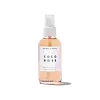What's inside
What's inside
 Key Ingredients
Key Ingredients

 Benefits
Benefits

 Concerns
Concerns

 Ingredients Side-by-side
Ingredients Side-by-side

Vitis Vinifera Seed Oil
EmollientTriolein
Skin ConditioningCaprylic/Capric Triglyceride
MaskingShea Butter Ethyl Esters
EmollientOlus Oil
EmollientParfum
MaskingPelargonium Graveolens Oil
MaskingTocopherol
AntioxidantSalvia Sclarea Extract
AntiseborrhoeicCupressus Sempervirens Leaf/Stem Extract
Skin ConditioningRosmarinus Officinalis Leaf Oil
MaskingGelidium Cartilagineum Extract
Skin ProtectingPhytosterols
Skin ConditioningCamelina Sativa Seed Oil
Skin ConditioningLaminaria Digitata Extract
Skin ProtectingHelianthus Annuus Seed Oil
EmollientPlankton Extract
Skin ConditioningCitric Acid
BufferingCitronellol
PerfumingGeraniol
PerfumingLimonene
PerfumingLinalool
PerfumingVitis Vinifera Seed Oil, Triolein, Caprylic/Capric Triglyceride, Shea Butter Ethyl Esters, Olus Oil, Parfum, Pelargonium Graveolens Oil, Tocopherol, Salvia Sclarea Extract, Cupressus Sempervirens Leaf/Stem Extract, Rosmarinus Officinalis Leaf Oil, Gelidium Cartilagineum Extract, Phytosterols, Camelina Sativa Seed Oil, Laminaria Digitata Extract, Helianthus Annuus Seed Oil, Plankton Extract, Citric Acid, Citronellol, Geraniol, Limonene, Linalool
Squalane
EmollientCaprylic/Capric Triglyceride
MaskingSesamum Indicum Seed Oil
EmollientUbiquinone
AntioxidantBorago Officinalis Seed Oil
EmollientTocopherol
AntioxidantCocos Nucifera Fruit Extract
EmollientRosa Damascena Flower Extract
MaskingEclipta Prostrata Extract
Skin ConditioningMelia Azadirachta Leaf Extract
Skin ConditioningMoringa Oleifera Seed Oil
EmollientCitronellol
PerfumingGeraniol
PerfumingEugenol
PerfumingLimonene
PerfumingSqualane, Caprylic/Capric Triglyceride, Sesamum Indicum Seed Oil, Ubiquinone, Borago Officinalis Seed Oil, Tocopherol, Cocos Nucifera Fruit Extract, Rosa Damascena Flower Extract, Eclipta Prostrata Extract, Melia Azadirachta Leaf Extract, Moringa Oleifera Seed Oil, Citronellol, Geraniol, Eugenol, Limonene
Ingredients Explained
These ingredients are found in both products.
Ingredients higher up in an ingredient list are typically present in a larger amount.
This ingredient is an emollient, solvent, and texture enhancer. It is considered a skin-softener by helping the skin prevent moisture loss.
It helps thicken a product's formula and makes it easier to spread by dissolving clumping compounds.
Caprylic Triglyceride is made by combining glycerin with coconut oil, forming a clear liquid.
While there is an assumption Caprylic Triglyceride can clog pores due to it being derived from coconut oil, there is no research supporting this.
Learn more about Caprylic/Capric TriglycerideCitronellol is used to add fragrance/parfum to a product. It is often derived from plants such as roses. In fact, it can be found in many essential oils including geranium, lavender, neroli, and more. The scent of Citronellol is often described as "fresh, grassy, and citrus-like".
Since the Citronellol molecule is already unstable, Citronellol becomes irritating on the skin when exposed to air.
Citronellol is a modified terpene. Terpenes are unsaturated hydrocarbons found in plants. They make up the primary part of essential oils.
Citronellol is not able to be absorbed into deeper layers of the skin. It has low permeability,
Citronellol is also a natural insect repellent.
Learn more about CitronellolGeraniol is used to add fragrance/parfum to a product. It is the main component of citronellol. It is a monoterpenoid and an alcohol.
Monoterpenes are naturally found in many parts of different plants.
Geraniol can be found in many essential oils including Rose Oil and Citronella Oil. The scent of Geraniol is often described as "rose-like". Many foods also contain Geraniol for fruit flavoring.
Geraniol can irritate the skin when exposed to air. However, irritation depends on the ability of geraniol to penetrate into the skin. In general, geraniol is not able to penetrate skin easily.
Geraniol is colorless and has low water-solubility. However, it is soluble in common organic solvents.
Like citronellol, it is a natural insect repellent.
2,6-Octadien-1-ol, 3,7-dimethyl-, (2E)-
Learn more about GeraniolLimonene is a fragrance that adds scent and taste to a formulation.
It's found in the peel oil of citrus fruits and other plants such as lavender and eucalyptus. The scent of limonene is generally described as "sweet citrus".
Limonene acts as an antioxidant, meaning it helps neutralize free radicals.
When exposed to air, oxidized limonene may sensitize the skin. Because of this, limonene is often avoided by people with sensitive skin.
The term 'fragrance' is not regulated in many countries. In many cases, it is up to the brand to define this term. For instance, many brands choose to label themselves as "fragrance-free" because they are not using synthetic fragrances. However, their products may still contain ingredients such as essential oils that are considered a fragrance.
Learn more about LimoneneTocopherol (also known as Vitamin E) is a common antioxidant used to help protect the skin from free-radicals and strengthen the skin barrier. It's also fat soluble - this means our skin is great at absorbing it.
Vitamin E also helps keep your natural skin lipids healthy. Your lipid skin barrier naturally consists of lipids, ceramides, and fatty acids. Vitamin E offers extra protection for your skin’s lipid barrier, keeping your skin healthy and nourished.
Another benefit is a bit of UV protection. Vitamin E helps reduce the damage caused by UVB rays. (It should not replace your sunscreen). Combining it with Vitamin C can decrease sunburned cells and hyperpigmentation after UV exposure.
You might have noticed Vitamin E + C often paired together. This is because it is great at stabilizing Vitamin C. Using the two together helps increase the effectiveness of both ingredients.
There are often claims that Vitamin E can reduce/prevent scarring, but these claims haven't been confirmed by scientific research.
Learn more about Tocopherol